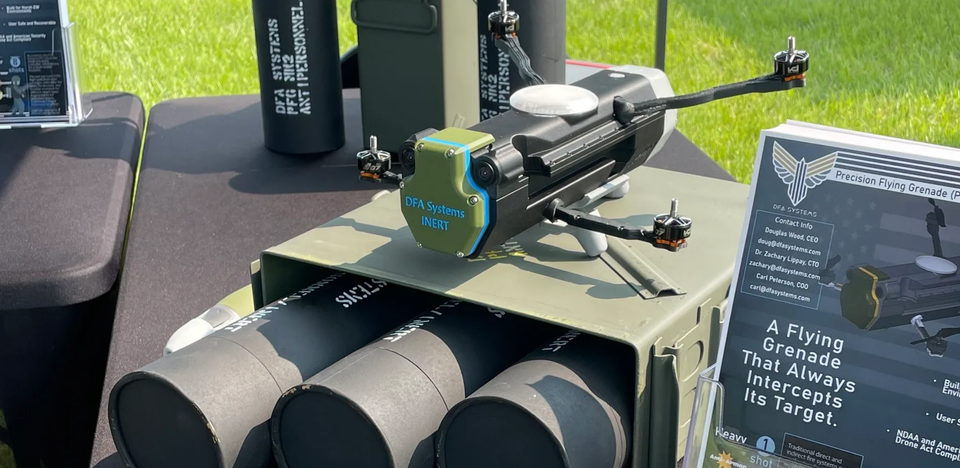Company Highlight: DFA Systems (Precision Flying Grenades)

I'd like to start using this newsletter to highlight interesting companies I come across from time to time. The first of these is DFA Systems, a New Mexico-based startup building lightweight, modular weapons drones.
If you're not already plugged into the defense tech world, I'll give a quick recap of the general situation going on with drones. Basically, as advanced technology has gotten cheaper, smaller, and more widely distributed around the globe, cheap and capable munitions delivered by autonomous platforms have proliferated. In the 1990s and early 2000s, the United States had the advantage of using GPS and laser-guided systems to drop bombs precisely, while our adversaries generally didn't have this (expensive) precision strike capability. Today just about anyone in the world can buy an inexpensive consumer drone, modify it, and strap a bomb to it. Now every armed force in the world has access to precision munitions with ranges of tens to hundreds of kilometers. The mass deployment of drone systems has revolutionized the modern battlefield in the same way the machine gun and long-range artillery changed the state of warfare in WW1.
Quick Facts:
- Ukraine and Russia produce more than 2 million weaponized drones per year
- As of 2024, China produces 6 million civilian drones per year
- The US military has fewer than 5,000 small drones in 2025

The test bed for weapons drones today is Ukraine. Drones of all sizes are used to scout and attack. They are so prolific on the Ukrainian front that they've forced combatants to adopt WW1 style trench warfare. Large troop or vehicle formations are instantly spotted and queued for attack by drones, at all hours of the day and night. Now even small formations have access to reliable observation and precision attack capabilities that in previous days would have required calling expensive aircraft. In today's world, even a squad-sized element carries a miniature air force in their rucksacks. The implications of this change are undeniable: 80% of all Russian casualties in Ukraine are due to small drones.
However, the majority of small drones being used in combat in Ukraine are adapted from consumer technology. They are vulnerable to radio jamming and limited in what they can accomplish because they haven't been purpose-built for combat. As combat drones improve, they will tend towards even greater effectiveness. Small weaponized drones will be the battle rifle of the future.
The State of American Small Weaponized Drones
There's an enormous gap here, and also an opportunity. Currently, China produces 97% of the small drone market. While the DOD has formally recognized that the U.S. needs to catch up with the ability to mass-produce cheap and capable small drones, the U.S. defense market lags woefully behind. U.S. forces currently have less than 5,000 small drones in active use, and none of which was purposefully designed as weaponized systems.
Enter DFA Systems, a new startup at the forefront of designing cheap drones from the ground up that are adapted for combat use. At the Reindustrialize conference in July I got to meet the team. Founder and CEO Doug Wood is a Marine Corps veteran with deep experience in electronic warfare systems. I also got to handle one of their model drones, the Precision Flying Grenade. It's lightweight, modular, has a frequency hopping radio to protect against jamming, and features provisions for autonomous terminal attack guidance. As a former artilleryman whose job it was to put "effects on target," it's exactly the kind of thing that I wish I could have put in my rucksack while on patrol in Baghdad.

The team has shown very promising early traction. In July, they demonstrated their PFG drone to MARSOC. The representative was so impressed that DFA Systems was asked to provide MARSOC with a quote for an initial quantity of systems for testing.
This rapid movement from DOD aligns with exciting changes to the way drones can be procured. Following the release of SECDEF Hegseth's new drone policy, small unit commanders can now buy and test NDAA compliant drones. O-6 commanders can now nominate drones for the Defense Innovation Unit "Blue List," an approval that nominates select drone systems for large purchase orders by any General or Admiral across the DOD. Combined with the FY26 National Defense Authorization Act budget, which authorizes $5B for unmanned systems, $16B for low cost weapons, $25B for munitions, and $2B for DIU aligned tech, these streamlined acquisition policies will allow the release of billions in federal dollars for the development of the domestic defense drone market.
DFA Systems is well-positioned to take advantage of the coming drone boom and solve a critical need in the defense market. They are actively seeking investment, and have soft-circled a $1.25 million raise from four firms, pending the involvement of a lead investor. If you are interested in speaking with Doug Wood at DFA about a potential investment I will be happy to connect you.